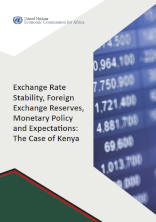Exchange Rate Stability, Foreign Exchange Reserves, Monetary Policy and Expectations: The Case of Kenya

The objective of this study is twofold: first, to empirically investigate the impact of monetary policy instruments on nominal and real exchange rates; and, second, to assess the role of expectations, speculation and other macroeconomic fundamentals on nominal and real exchange rates. In addition, in the study, the determinants of foreign exchange reserves are reviewed, using a time series monthly data for the period 2000–2017. Several techniques are employed, including, in particular, autoregressive distributed lag models, which use the bound-testing technique. The analysis finds varying short-run and long-run relationships. The results have several policy implications. First, expectations and speculations are more significant factors in exchange rate movement than foreign reserves. Second, the interventions in the domestic goods market to control prices may not only be costly but they could also worsen exchange rate movements. Third, macroeconomic fundamentals play a significant role in the stability of the foreign exchange market. Fourth, central banks need to consistently assess and evaluate the effectiveness of the instruments used to achieve stability.